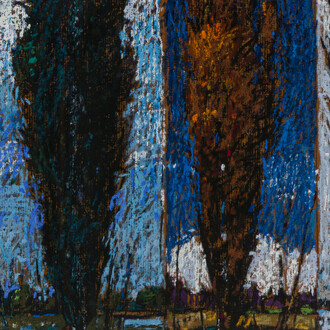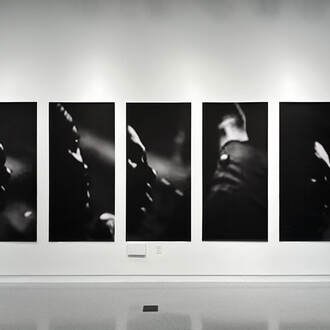Reynolds Gallery is pleased to announce the opening of Signs and spirits of lake Elster, a solo exhibition showcasing work by Will Connally. The exhibition opens on Tuesday, June 10, 2025 at our Main Street location. The show runs through August 22.
Will Connally’s photographs are based on an elaborate narrative that emerges from the fictional Lake Elster, a rural north-eastern lake. To stage these photographs, he has developed a series of short stories, sketches, fabricated props, and a detailed timeline spanning over 370 years from the European discovery of the lake. The works purposefully disguise narrative elements, encouraging viewers to imagine the untold pieces.
Connally draws inspiration for the original Lake Elster series from personal narratives, folklore, literature, film noir, and amateur theater productions. All elements of the scenes are photographed together in-camera on medium-format film, rather than collaged afterwards in post-production. The inclusion of flat, stage-like painted elements in each scene emphasizes the fictional nature of the narrative and calls into question the veracity of the photographs.
As the series has grown, Connally has photographed scenes set on Lake Elster on various bodies of fresh water across the United States, Canada, rural Finland, and most recently in western Ireland. While the story itself is set in a remote part of New Hampshire, Lake Elster has an odd, mythical quality in the photographs, where the proportions of the lake ebb and flow, mirroring the fictional narrative. Working in western Ireland this past summer, he was able to add a new sense of scale, color, and topography to the series. The photographs embrace the elusive, ever-changing quality of fiction, especially when retold by a narrator well into his nineties.
Step into the world of Signs and spirits of lake Elster. This show will take you on a journey through Connally’s exploration of narrative, storytelling, and portraiture surrounding the fictionalized Lake Elster and its residents. Connally’s photographs and installations absorb the viewer into his richly imagined surroundings through staged scenes replete with fabricated elements and symbolic objects. These images, eerie and absent of definitively formed figures, evoke the presence of characters who may never fully appear. As the viewer moves through the work, the line between history and hallucination grows increasingly blurred, creating a psychologically complex experience.
















